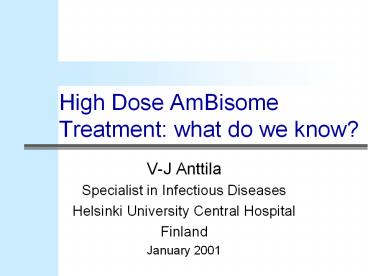High Dose AmBisome Treatment: what do we know? - PowerPoint PPT Presentation
1 / 14
Title:
High Dose AmBisome Treatment: what do we know?
Description:
40 years clinical experience with drug. Efficacy shown against most yeast and ... Investigations and splenic aspirations were done on day 0, 21 and day 180 ... – PowerPoint PPT presentation
Number of Views:151
Avg rating:3.0/5.0
Title: High Dose AmBisome Treatment: what do we know?
1
High Dose AmBisome Treatment what do we know?
- V-J Anttila
- Specialist in Infectious Diseases
- Helsinki University Central Hospital
- Finland
- January 2001
2
Amphotericin B Deoxycholate
- 40 years clinical experience with drug
- Efficacy shown against most yeast and mould
infections - In yeast infections 0.5mg- gt0.7 mg/kg/day may be
a sufficient dose - ?0.7 mg/kg/day may be needed
- in unstable patients with candidemia
- in infections caused by strains with reduced
susceptibility - In mould infections higher doses needed
- dose should be tapered to the maximum tolerated
level (e.g. 1-1.5 mg/kg/day)
3
Amphotericin B Deoxycholate
- Toxicity of Amphotericin B deoxycholate major
problem - renal toxicity
- Lipid formulations of amphotericin B indicated in
patients - with impaired renal function
- who develop nephrotoxicity while receiving
conventional amphotericin B
4
Liposomal Amphotericin B
- Efficacy at least as good as with conventional
amphotericin B - Better tolerated than conventional amphotericin B
- Less nephrotoxicity compared with conventional
amphotericin B - 3 mg/kg/day used in most studies
5
Liposomal Amphotericin BAmBisome
- High dose AmBisome treatment ?5 mg/kg/day-15
mg/kg/day used at least in three published
clinical studies - Thakur CP Int J Antimicrobial Agents
20011767-70 - Walsh et al ICAAC 1999 abstr 1640
- Buffels R et al ASH 2000 abstr 3395
6
Liposomal Amphotericin BAmBisome
- Thakur CP A single high dose treatment of
kala-azar with Ambisome (amphotericin B lipid
complex) a pilot study. Int J Antimicrobial
Agents 20011767-70 - 34 patients with parasitologically confirmed
visceral leishmaniasis - randomly divided
- 17 pts Ambisome 15 mg/kg as a single dose
- 17 pts amphotericin B deoxycholate 1 mg/kg for 20
days
7
Liposomal Amphotericin BAmBisome
- Thakur 2001 continued.
- Investigations and splenic aspirations were done
on day 0, 21 and day 180 - All 34 patients had a clinical, parasitological
and ultimate cure - AmBisome was better tolerated than conventional
amphotericin B - Adverse events in group AmBisome
- shivering during infusion 3 (17 )
- nausea 1 (6 )
- rise in serum creatinine 0
8
Liposomal Amphotericin BAmBisome
- Walsh TJ, Anaissie EJ, Goodman JL, Pappas P,
Bekersky I, Buell DN. High-Dose Liposomal
Amphotericin B in patients infected with
aspergillosis and other filamentous fungi.
Interscience Conference on Antimicrobial Agents
and Chemotherapy (ICAAC) 1999 573 - phase I-II study of the safety, tolerance and
plasma pharmacokinetics of Liposomal Amphotericin
B (AmBisome )
9
Liposomal Amphotericin BAmBisome
- Walsh et al ICAAC 1999 continued.
- Patients with infections due to Aspergillus spp
and other filamentous fungi - Dosage cohorts 7.5, 10.0, 12.5 and 15 mg/kg/day
- total number of patients 43 (8,10,7 and 19 per
group, respectively) - several patients extremely ill
10
Liposomal Amphotericin BAmBisome
- Walsh et al ICAAC 1999 continued.
- AmBisome was tolerated at all doses
- Adverse events
- fever 8 (19)
- chills/rigors 5 (12 )
- doubling of baseline creatinine in 32 of all
patients not dose related - Success rates(CR, PR or stabilization) 21/31 (68
) intent-to-treat and 18/24 (75) in the
evaluable (7 days on therapy) population
11
Liposomal Amphotericin BAmBisome
- Buffels R et al. Efficacy and safety of high
doses of liposomal amphotericin B (AmBisome ) in
treatment of patients with invasive fungal
infection. 42nd Annual Meeting of American
Society of Hematolology (ASH) 2000 abstr 3395) - 66 patients
- 35 adults, 21 children (?15 years), 10 neonates
12
Liposomal Amphotericin BAmBisome
- Buffels et al. 2000 ASH continued.
- Dose of AmBisome
- 5-7.5mg/day 59 pts
- 7.5-10 mg/kg/day 3 pts
- gt10mg/kg/day 10 pts
- 41 had confirmed fungal infection
- 24 Candida
- 12 Aspergillus
- 4 Mucor
- 5 Others
- 8 pts had probable fungal infection
- 7 pts had possible fungal infection
- 10 patients were treated empirically
13
Liposomal Amphotericin BAmBisome
- Buffels et al. AHA 2000 continued.
- Complete cure (CR) was obtained in 26/66 39.4
- Improvement (PR) 19/66 28.8
- CRPR 68
- 16 deaths were recorded 24.4
- 6 death caused by fungal infection 9.1
- In 2 patients the treatment was interrupted with
a moderate increase of serum creatinine
14
Liposomal Amphotericin BAmBisome
- High dose AmBisome treatment conclusion
- the dose can be increased up 15 mg/kg/day
- the tolerability of AmBisome 5-15 mg/kg/day is
accetable in patients with life-threatening deep
fungal infection - some kidney toxicity may occur
- controlled studies of the efficacy and
tolerability of high dose AmBisome are needed































